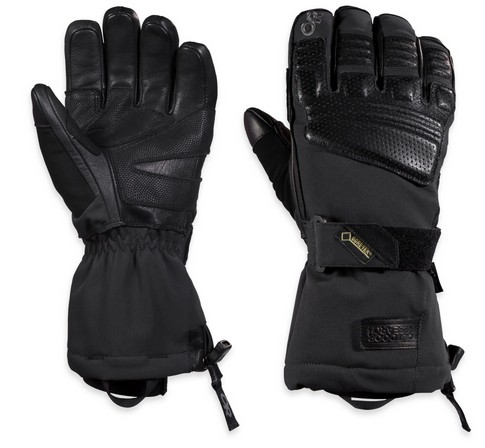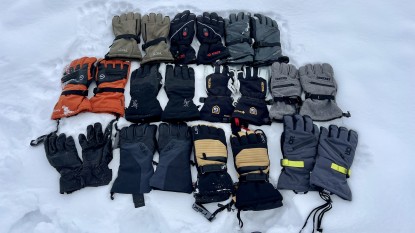Outdoor Research Olympus Sensor Review
Our Verdict
Our Analysis and Test Results
Warmth
The Olympus Sensor uses Outdoor Research's combination of a proprietary PrimaLoft-like insulation called EnduraLoft with 133 grams of this insulation on the palm and 200 grams on the back of the hand. The warm and cozy wool lining was loved by most of our testers, who agreed that these gloves functioned well when worn for resort skiing down to temps around 0F-10F. The molded EVA foam back panels provide a little bit of extra warmth as well as some hand protection.
The Olympus Sensor was easily one of the toastiest gloves in our review, far warmer than the overall average. In our direct comparisons, this glove even outperformed other warmer-than-average options, like the Dakine Titan and the Burton Gore-Tex, or the Gordini GTX Storm.
Dexterity
Considering the significantly above-average warmth of the Olympus Sensor, they proved to be fairly dexterous and performed well during our side-by-side and real-world comparison testing. We could easily open a locked car door and buckle our boots, but could only sloppily write our name. While this glove was slightly better in dexterity than the Black Diamond Guide, Burton Gore-Tex and the Dakine Titan but not quite as dexterous as the Hestra Army Leather Gore-Tex and our Editors' Choice the Hestra Vertical Cut Freeride.
Water Resistance
The Olympus Sensor scored above average in both our side-by-side, two-minute water bucket test and in real-world use on stormy, close-to-freezing days in the Pacific Northwest. These gloves have a GORE-TEX waterproof-breathable insert that has been placed inside highly water resistant leather. It was just barely outperformed by the Outdoor Research Mute Sensor, with the Black Diamond Legend offering comparable weather resistance.
The Olympus Sensor performed slightly better than the Hestra Army Leather Gore-Tex or the Hestra Vertical Cut Freeride, primarily because the Sensor's leather didn't need to be re-treated as often. Despite being an exceptionally warm glove, the Olympus Sensor is an excellent choice for wet and warm conditions in which folks' hands get cold more easily.
Durability
The Olympus Sensor Glove uses water resistant goat leather on both the inside of the fingers and the entire palm. While these gloves are tough, we found the Outdoor Research Mute Sensor and Hestra Fall Line were a touch higher on the overall toughness scale, scoring a 9 and 10. We do think the Olympus Sensors are comparable to the Black Diamond Guide and the Hestra Army Leather Gore-Tex.
Features
These gloves have a slew of sweet features, but what really sets them apart from other competitors (and what will be attractive and likely deciding factor to most people) is their extremely effective touchscreen ability. There just aren't many gloves that offer this level of warmth while featuring this capability. We wore these gloves in wet weather, as well as in cold and dry conditions, with the touchscreen compatible thumb and finger always proving to be effective. In colder conditions, it was often more effective to use the touchscreen with the glove versus our bare hand.
The Olympus Sensor has wrist leashes that are low profile, comfortable and able to be hidden under the gauntlet of the glove. We liked these removable wrist leashes far more than the others because of their low profile nature. Even if you are skeptical of this feature, as we first were, once you use them, you'll hardly notice that you're wearing them. Even better, you'll love that you don't have to stress or find a safe place to set them down, especially if you're forced to remove your gloves.
Value
At $175, the Olympus Sensor Gloves are certainly one of the more expensive pairs of gloves in our review, however, they are in line with similarly designed gloves that provide a similar level of warmth; they are the same price as the Hestra Army Leather Gore-Tex ($175) and $5 more than the Black Diamond Guide ($170). In the end, we found that this contender offers nice features (especially the touch screen-sensitive fingers) a durable and long lasting design, and above average warmth, all at a solid value.
Best Applications and the Bottom Line
The OR Olympus Sensor Gloves are best for folks that find they get cold hands easily or frequently ride or ski in chillier climates. Their super functional touchscreen sensitive thumb and index finger work extremely well and is the best we've used. They perform well when worn down to 0F or warmer, but many people will not find them toasty enough when the temperature gets much colder than that.




